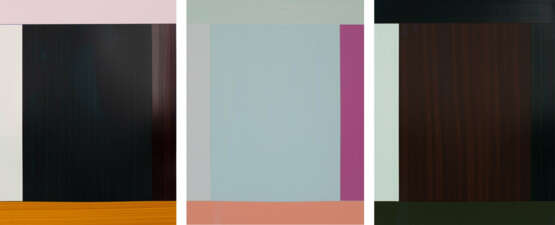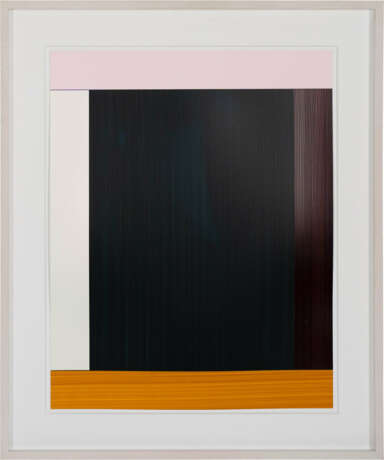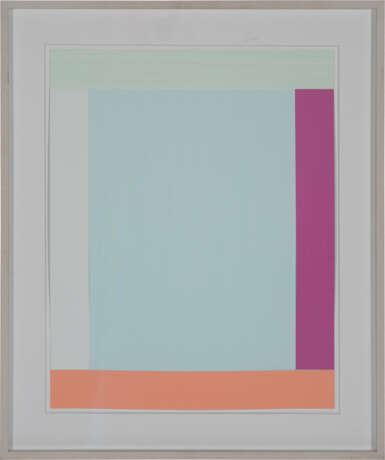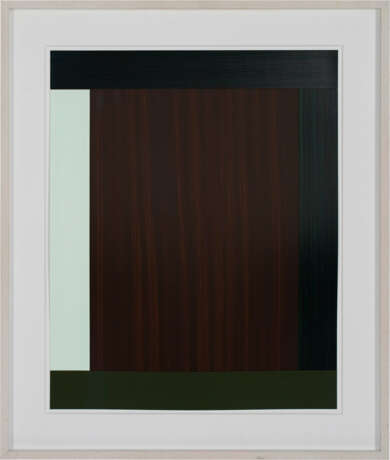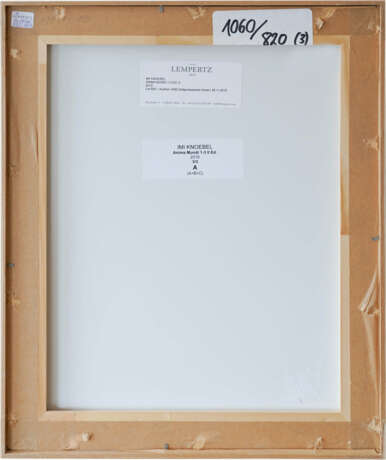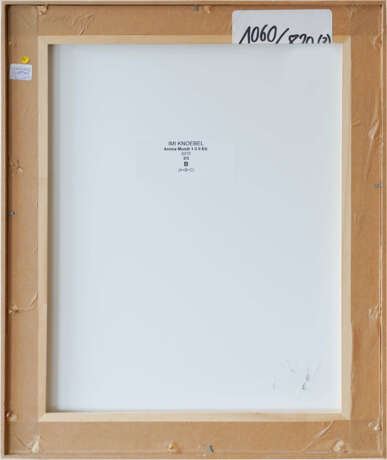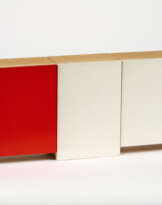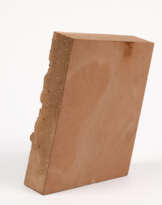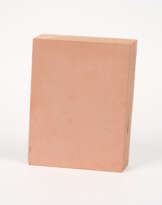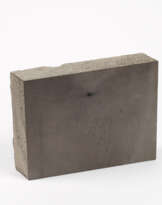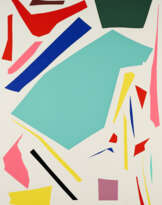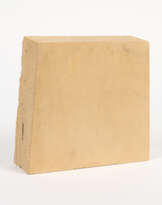ID 952225
Лот 103 | Imi Knoebel (1940 Dessau) (F)
Оценочная стоимость
€ 8 500 – 11 000
'Anima Mundi 1-3 Ed. II', 3-tlg., je Acryl auf collagierter Kunststofffolie, 37 cm x 29 cm, verso mit Etikett, betitelt, 2010 datiert, '1/3' - '3/3' bezeichnet, Exemplar 3/3, montiert, montierungsbedingt leicht gewellt
Imi Knoebel studierte 1964-71 an der Düsseldorfer Kunstakademie bei Joseph Beuys. Anfänglich angeregt durch den russischen Konstruktivismus beschäftigt sich Knoebel mit dem Verhältnis von Farbe und Raum. Offenkundig bezieht sich Knoebel auf das weltbekannte "Schwarze Quadrat" des Künstlers Kasimir Malewitsch, welches sich primär und ganz eindeutig von der abbildenden Idee der Kunst freimachte. Mit seiner Arbeit antwortet der Künstler durch sein gesamtes Oeuvre hindurch, auf die Fragen der zeitgenössischen Kunst: Raum, Bild, Betrachter, Perspektive - wozu ist die Kunst da? All diese Aspekte stehen in unserer heutigen Zeit in Frage und werden somit auch von Imi Knoebel bearbeitet, bis er das was ein ursprünglich gedachtes Gemälde - nämlich Farbe und Form auf Leinwand - weglässt und den Keilrahmen selbst als Kunstwerk erhebt. Dazu lotet der Künstler Aspekte der Materialität, der Zwei- und Dreidimensionalität, sowie konstruierte und zufällige Raumprinzipien aus. Mit den Jahren entstehen Materialassemblagen und Zeichnungen, Scherenschnitte, klein- und großformatige Arbeiten mit monochrom gefassten und ebenso polychrom zusammengestellte Werke. Innerhalb der 1990er Jahre entwickelt Knoebel ein Interesse für Aluminium als Farbträger, wodurch er Struktur, Gliederung, Rhythmus und die Vielfalt der Farbe zusammensetzen kann, wie es ihm beliebt. Schichtungen des Materials, Formen, Linien und Räume der Farbe entstehen aus Farbflächen, die durch ihren Aufbau und die Leuchtkraft jeder Farbe in den Raum des Betrachters vordringen. Die sogenannte und an dieser Stelle titelgebende "Anima Mundi" (dt. die Weltseele) kann als religiöses oder naturphilosophisches Konzept angesehen werden und beschreibt wohl die Analogie der Gesamtheit des Kosmos und dem einzelnen Lebewesen, dem Menschen. Das Universum als Makrokosmos soll analog zum Menschen, dem Mikrokosmos, strukturiert sein. Doch wie kann dieses weitreichende und umfangreiche Konzept auf ein Kunstwerk bezogen werden? So wie ein Bild im künstlerisch-handwerklichen Sinne Knoebels zusammengesetzt werden kann, kann es ebenso in seine Einzelteile zerlegt werden, wodurch Grundformen entstehen, die selbst wieder Bildfunktionen in sich tragen. In unserer präsentierten dreiteiligen Edition der Werkserie "Anima Mundi" setzt der Künstler das Prinzip des eingerahmten Bildes in verschiedenfarbige Farbflächen aus Acryl auf collagierter Kunststofffolie zurecht. Jedes der drei Teile in jeweils anderer Kolorit-Komposition: Eines in braun mit schwarz und Grüntönen; ein Zweites in hellblau, mit limettengrüner, weißer, pinker und korallfarbener Farbfläche und ein Drittes in schwarz, mit rosé, bordeaux, orange und cremefarbenem Farbauftrag. Wesentlich erscheint dabei die Freiheit der Farbzusammensetzung und der Zusammensetzung der einzelnen Bildelemente, die vielleicht sogar auf die Freiheit eines jeden Menschen im Konstrukt der Welt übertragen werden könnte. Ein Jeder selbst, als Teil der "Anima Mundi".
Imi Knoebel (1940 Dessau) (F)
'Anima Mundi 1-3 Ed. II', 3 parts, each acrylic on collaged plastic foil, 37 cm x 29 cm, label on verso, titled, dated 2010, inscribed '1/3' - '3/3', example 3/3, mounted, slightly wavy due to mounting.
Imi Knoebel studied at the Düsseldorf Art Academy under Joseph Beuys from 1964-71. Initially inspired by Russian Constructivism, Knoebel explored the relationship between colour and space. Knoebel obviously refers to the world-famous ''Black Square'' by the artist Kasimir Malevich, which primarily and clearly freed itself from the depictive idea of art. With his work, the artist answers the questions of contemporary art throughout his entire oeuvre: space, image, viewer, perspective - what is art for? All these aspects are in question in our time and are also dealt with by Imi Knoebel, until he leaves out what was originally intended to be a painting - namely colour and form on canvas - and elevates the stretcher frame itself as a work of art. To this end, the artist explores aspects of materiality, two- and three-dimensionality, as well as constructed and accidental spatial principles. Over the years, material assemblages and drawings, silhouettes, small and large-format works with monochrome painted and equally polychrome assembled works. In the 1990s, Knoebel developed an interest in aluminium as a colour carrier, which allowed him to put together structure, rhythm and the diversity of colour, as he pleased. Layers of the material, forms, lines and spaces of colour emerge from areas of colour that steps into the viewer's space through their structure and the luminosity of each colour. The so-called and at this point title-giving ''Anima Mundi'' (engl. the world soul) can be seen as a religious or natural philosophical concept and probably describes the analogy of the totality of the cosmos and the individual living being, the human being. The universe as a macrocosm is supposed to be structured analogously to the human being, the microcosm. But how can this far-reaching and extensive concept be related to a work of art? Just as a picture can be put together in Knoebel's artistic sense, it can also be broken down into its individual parts, creating basic forms that themselves carry pictorial functions. In our presented three-part edition of the work series ''Anima Mundi'', the artist puts the principle of the framed picture into different coloured acrylic surfaces on collaged plastic foil. Each of the three parts has a different colour composition: one in brown with black and green tones; a second in light blue, with lime green, white, pink and coral coloured areas and a third in black, with rosé, bordeaux, orange and cream coloured areas. What seems essential here is the freedom of the colour composition and the composition of the individual picture elements, which could perhaps even be transferred to the freedom of each person in the construct of the world. Each one himself, as part of the ''Anima Mundi''.
| Автор: | Ими Кнёбель (1940) |
|---|---|
| Категория аукционного дома: | Живопись 19-го и 20-го веков |
| Автор: | Ими Кнёбель (1940) |
|---|---|
| Категория аукционного дома: | Живопись 19-го и 20-го веков |
| Адрес торгов |
WETTMANN Luxusuhren Bredeneyer Straße 119-121 45133 Essen Германия | ||||||||||||||
|---|---|---|---|---|---|---|---|---|---|---|---|---|---|---|---|
| Предосмотр |
| ||||||||||||||
| Телефон | +4920185785190 | ||||||||||||||
| Факс | +49 (0)208 439 17 35 | ||||||||||||||
| Комиссия | 14,28% | ||||||||||||||
| Условия использования | Условия использования | ||||||||||||||
| Транспортировка |
Почтовая служба Курьерская служба Самовывоз | ||||||||||||||
| Способы оплаты |
Банковский перевод | ||||||||||||||
| Часы работы | Часы работы
|
